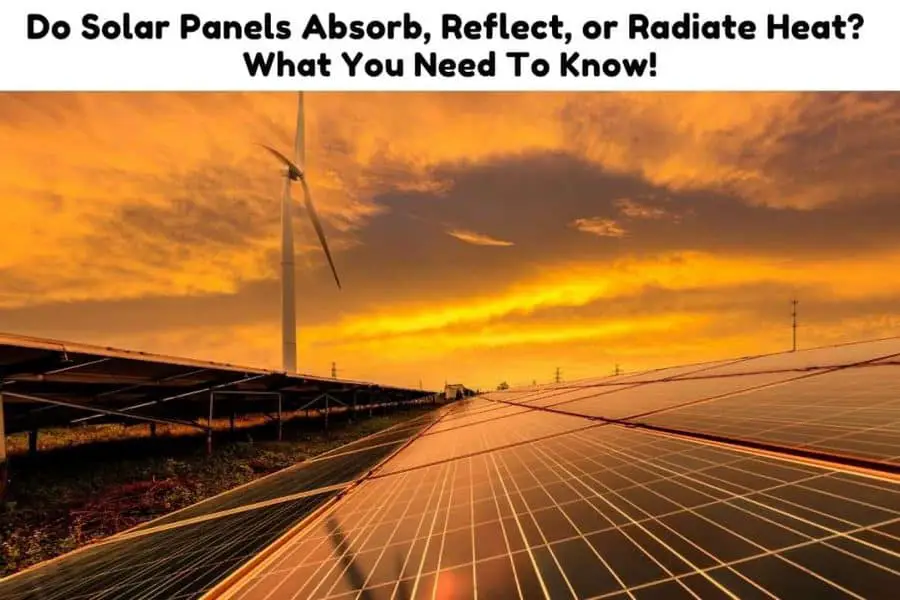Sunlight travels at 186,000 miles per second to reach Earth. Taking approximately 8 minutes and 20 seconds to reach Earth, it is either absorbed or reflected into the sky.
What happens when some of that sunlight hits a surface like a solar panel? Like any other surface exposed to solar radiation, solar panels absorb, reflect, and radiate the sun’s energy as both heat and light.
But in what proportions does this occur? Many people misunderstand how solar panels work. Most people hold the misconception that solar panels generate electricity by absorbing heat. This widely held belief is wildly inaccurate.
This article explores the relationship between solar panels and heat. We will look into the specifics of how solar panels create energy and what role if any heat plays. We will also look at what impact solar panels have on the temperature of a house.
On a side note! If you’re in need of a reliable and high-performance portable solar panel, We strongly recommend the Jackery SolarSaga 100W Portable Solar Panel (Amazon Link).
With a high conversion efficiency and foldable design, this solar panel is easy to transport and set up, making it perfect for outdoor activities like camping, hiking, and RV trips.

The US solar cell technology used in this panel ensures that you get the most efficient and reliable solar charging possible.
There is also a 60W option that is more affordable (Amazon Link)

Do Solar Panels Use Heat or Light to Produce Electricity?
Contrary to what most people believe, solar panels produce energy from light and not heat. Heat reduces the effectiveness of solar panels. The hotter a solar panel becomes, the less energy it produces.
This is what is known as the temperature coefficient of a solar panel. The temperature coefficient is a measure of how much energy a solar panel produces with every 1°C rise in temperature above 25°C. 25°C is the optimum temperature at which a solar panel will produce its maximum rated power. Solar panels need to be cooler, not hotter.
For more on this topic, check out our post Do Solar Panels Reflect Or Absorb Light? All You Need to Know! & Do Solar Panels Overheat? Is it a Big Deal!
If heat is not used to produce energy in a solar panel what then happens to it?
Do Solar Panels Reflect Heat Into the Atmosphere?
Solar panels absorb about 30% of the sun’s heat energy. Half of that heat is reflected in the atmosphere. Solar panels convert light into solar energy. Heat on the other hand decreases the amount of energy a solar panel produces.
Surfaces exposed to the sun absorb and reflect heat to varying degrees. Darker surfaces absorb more heat compared to lighter surfaces which reflect more heat. That is why if you wear a dark shirt on a bright day you feel hotter than you would if you wore a white shirt.
This is also why when you look at asphalt on a hot day it looks like it is “boiling”. That is heat escaping from the asphalt. Solar panels also experience this although to a lesser extent. This is called the urban heat island effect.
The urban heat island describes the effect of increased temperatures caused by the greater absorption of heat energy caused by manmade objects. Growing cities with large concrete buildings and asphalt streets are thought to be contributing factors to increased rates of global warming. (Source)
Also, check out “Do Solar Panels Make Your House Hotter or Cooler ?!“
Do Solar Panels Trap Heat?
Solar panels are coated with a material that makes them darker to absorb more light. Conversely, this also makes them absorb more heat. Some of that heat is trapped within the frame of the solar panel.
The heat beneath a solar panel does present an opportunity to produce a second source of energy. Some small studies into thermoelectricity are looking into tapping into the heat energy produced by solar panels. (Source)
For more on this topic, check out our post Do Solar Panels Keep Your Roof Cool?
Do Solar Panels Reflect the Sunlight?
Solar panels reflect less than 3% of sunlight. This is because solar panels are engineered to absorb more light through the use of an anti-reflective coating. The coating decreases the reflection of a solar panel by 30%.
Anti-reflective coating tints the color of a solar panel to a darker shade of blue and in the case of monocrystalline solar panels, black. The darker a surface is the more sunlight it will absorb. The more light a solar panel can absorb, the higher its energy output will be. This is the main reason why monocrystalline solar panels are the most efficient solar panels on the market. (Source)
Do Solar Panels Make a House Hotter?
Solar panels do not make a house hotter. The ambient temperature of a roof will not rise if the roof has solar panels. Rooftop solar panels have the opposite effect. They reduce the temperature of a house.
How do solar panels cool a house? Solar panels shade and insulate the roof of a house from direct sunlight. In a study conducted at the San Diego Jacobs School of Engineering, researchers found that the ceiling of a building with solar panels over it was cooler by five degrees Fahrenheit than a building without solar panels. (Source)
Instead of the sun hitting the roof directly, solar panels act as shades that absorb most of the heat. The heat that would otherwise be pushed down into the ceiling and the rest of the building is dispersed by the wind. This works more effectively when there is a gap between the solar panels and the roof.
Heating and cooling a home take up more than 40% of a home’s energy demands. Solar panels can thus reduce the energy demand on the grid directly by providing an energy source and indirectly by reducing the need for air conditioning.
Do Solar Panels Need the Sun or Just Light?
Solar panels produce energy from light. A light source can be the sun or artificial light sources like LED light bulbs. Solar panels can even generate electricity from moonlight although this is a tiny amount of energy.
Solar panels use a wide spectrum of light to produce energy. This light is found in the greatest intensity in the sun but other light sources have it as well.
Different experiments have been carried out to determine what type of light can be used to generate solar energy. In a study using artificial light, researchers tested different types of solar panels against different types of light.
They tested silicon crystalline solar panels with different types of lights including LEDs, incandescent, and fluorescent lights. Through their experiments, they found that the combination of monocrystalline and incandescent lights produces more energy. (Source)
Direct sunlight however is the best source of light from which a solar panel can produce energy from. The sun has more energy than all of Earth’s other sources of energy including gas, coal, methane, and even nuclear power plants.

